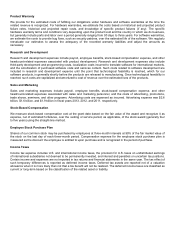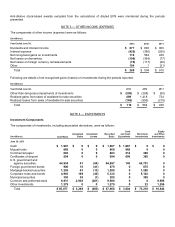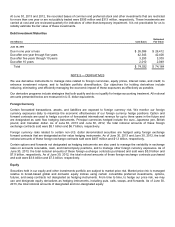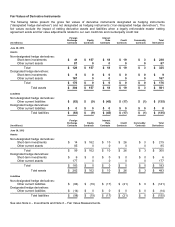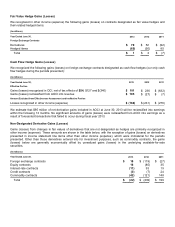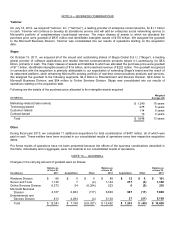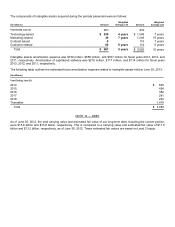Microsoft 2013 Annual Report Download - page 57
Download and view the complete annual report
Please find page 57 of the 2013 Microsoft annual report below. You can navigate through the pages in the report by either clicking on the pages listed below, or by using the keyword search tool below to find specific information within the annual report.contracts purchased and sold were $898 million and $1.0 billion, respectively. As of June 30, 2012, the total notional
amounts of designated and non-designated equity contracts purchased and sold were $1.4 billion and $982 million,
respectively.
Interest Rate
Securities held in our fixed-income portfolio are subject to different interest rate risks based on their maturities. We
manage the average maturity of our fixed-income portfolio to achieve economic returns that correlate to certain broad-
based fixed-income indices using exchange-traded option and futures contracts and over-the-counter swap and option
contracts, none of which are designated as hedging instruments. As of June 30, 2013, the total notional amounts of fixed-
interest rate contracts purchased and sold were $1.1 billion and $809 million, respectively. As of June 30, 2012, the total
notional amounts of fixed-interest rate contracts purchased and sold were $3.2 billion and $1.9 billion, respectively.
In addition, we use “To Be Announced” forward purchase commitments of mortgage-backed assets to gain exposure to
agency mortgage-backed securities. These meet the definition of a derivative instrument in cases where physical delivery
of the assets is not taken at the earliest available delivery date. As of June 30, 2013 and 2012, the total notional derivative
amounts of mortgage contracts purchased were $1.2 billion and $1.1 billion, respectively.
Credit
Our fixed-income portfolio is diversified and consists primarily of investment-grade securities. We use credit default swap
contracts, not designated as hedging instruments, to manage credit exposures relative to broad-based indices and to
facilitate portfolio diversification. We use credit default swaps as they are a low cost method of managing exposure to
individual credit risks or groups of credit risks. As of June 30, 2013, the total notional amounts of credit contracts
purchased and sold were $377 million and $501 million, respectively. As of June 30, 2012, the total notional amounts of
credit contracts purchased and sold were $318 million and $456 million, respectively.
Commodity
We use broad-based commodity exposures to enhance portfolio returns and to facilitate portfolio diversification. We use
swaps, futures, and option contracts, not designated as hedging instruments, to generate and manage exposures to
broad-based commodity indices. We use derivatives on commodities as they can be low-cost alternatives to the purchase
and storage of a variety of commodities, including, but not limited to, precious metals, energy, and grain. As of June 30,
2013, the total notional amounts of commodity contracts purchased and sold were $1.2 billion and $249 million,
respectively. As of June 30, 2012, the total notional amounts of commodity contracts purchased and sold were $1.5 billion
and $445 million, respectively.
Credit-Risk-Related Contingent Features
Certain of our counterparty agreements for derivative instruments contain provisions that require our issued and
outstanding long-term unsecured debt to maintain an investment grade credit rating and require us to maintain minimum
liquidity of $1.0 billion. To the extent we fail to meet these requirements, we will be required to post collateral, similar to
the standard convention related to over-the-counter derivatives. As of June 30, 2013, our long-term unsecured debt rating
was AAA, and cash investments were in excess of $1.0 billion. As a result, no collateral was required to be posted.




